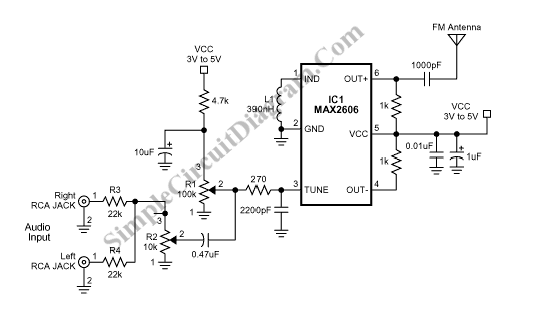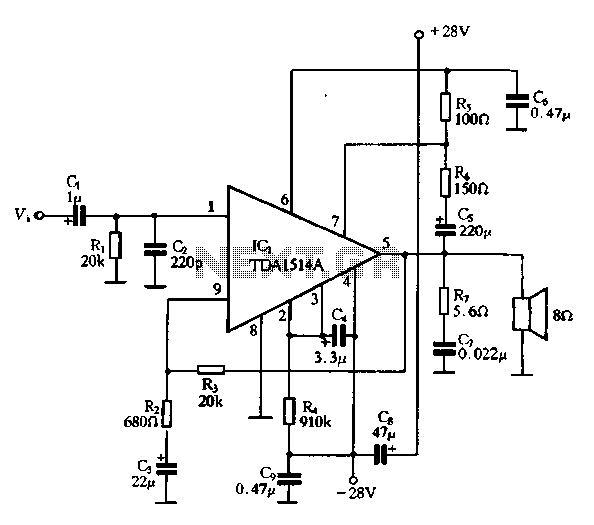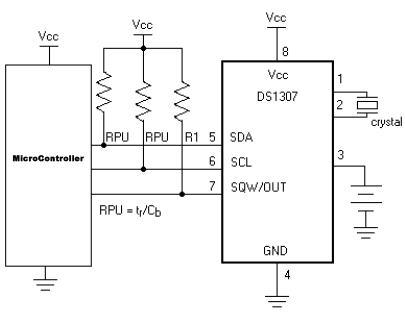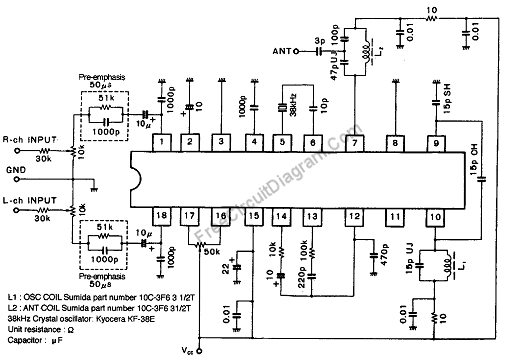
Single Chip FM Transmitter For Short Range Application

The FM transmitter circuit operates within the broadcast band of 88 to 108 MHz and can be utilized to transmit audio signals for remote listening. The output power...
The FM transmitter circuit is designed to function within the frequency range of 88 to 108 MHz, which is the standard FM broadcast band. This circuit is capable of transmitting audio signals, making it suitable for applications such as personal radio broadcasts, remote audio streaming, or educational purposes.
The core components of the FM transmitter include an audio input stage, an oscillator, a modulator, and an output stage. The audio input stage typically consists of a microphone or line-level audio source that converts sound waves into electrical signals. These signals are then fed into the oscillator, which generates a carrier wave at a specific frequency within the FM band.
The modulator is responsible for varying the frequency of the carrier wave in accordance with the input audio signals, effectively encoding the audio information onto the carrier wave. This modulation allows the audio signals to be transmitted over the airwaves.
The output stage amplifies the modulated signal to ensure it has sufficient power to be transmitted over longer distances. The output power can be adjusted based on the design of the circuit, which may involve the use of transistors or integrated circuits to achieve the desired amplification.
Additionally, the circuit may include components such as filters to reduce unwanted harmonics and improve signal quality, as well as an antenna for effective radiation of the transmitted signal. The choice of antenna type and its design is critical for optimizing transmission range and clarity.
Overall, this FM transmitter circuit serves as a versatile tool for audio broadcasting, enabling users to share audio content wirelessly within a designated area. Proper tuning and setup are essential to ensure compliance with local regulations regarding radio frequency transmission.The FM transmitter circuit here works in the broadcast band 88 to 108MHz, and can be used to broadcast audio signals for remote listening. The output power.. 🔗 External reference
The FM transmitter circuit is designed to function within the frequency range of 88 to 108 MHz, which is the standard FM broadcast band. This circuit is capable of transmitting audio signals, making it suitable for applications such as personal radio broadcasts, remote audio streaming, or educational purposes.
The core components of the FM transmitter include an audio input stage, an oscillator, a modulator, and an output stage. The audio input stage typically consists of a microphone or line-level audio source that converts sound waves into electrical signals. These signals are then fed into the oscillator, which generates a carrier wave at a specific frequency within the FM band.
The modulator is responsible for varying the frequency of the carrier wave in accordance with the input audio signals, effectively encoding the audio information onto the carrier wave. This modulation allows the audio signals to be transmitted over the airwaves.
The output stage amplifies the modulated signal to ensure it has sufficient power to be transmitted over longer distances. The output power can be adjusted based on the design of the circuit, which may involve the use of transistors or integrated circuits to achieve the desired amplification.
Additionally, the circuit may include components such as filters to reduce unwanted harmonics and improve signal quality, as well as an antenna for effective radiation of the transmitted signal. The choice of antenna type and its design is critical for optimizing transmission range and clarity.
Overall, this FM transmitter circuit serves as a versatile tool for audio broadcasting, enabling users to share audio content wirelessly within a designated area. Proper tuning and setup are essential to ensure compliance with local regulations regarding radio frequency transmission.The FM transmitter circuit here works in the broadcast band 88 to 108MHz, and can be used to broadcast audio signals for remote listening. The output power.. 🔗 External reference





